run flat TOYOTA CAMRY 2020 Warranties & Maintenance Guides (in English)
[x] Cancel search | Manufacturer: TOYOTA, Model Year: 2020, Model line: CAMRY, Model: TOYOTA CAMRY 2020Pages: 260, PDF Size: 8.54 MB
Page 55 of 260

BRIDGESTONE / FIRESTONE
53
flat operation is pressure at or below 10 psi (70 kPa); however, some
vehicle manufacturers may have established a different pressure
limit. Consult your vehicle owner’s manual for the details of your
TPMS. Once the TPMS has indicated that a tire has reduced inflation
pressure, the run-flat mode of operation has commenced. During this
phase of operation, please follow these instructions:•
Reduce speed as much as safely and reasonably possible; do
not exceed 50 mph (80 km/h). The greater the speed, the less
distance the tire can travel.
•
Avoid abrupt or aggressive acceleration, braking, or cornering
maneuvers as much as safely and reasonably possible. Pot
holes and other road hazards should be avoided. Careful driving
limits potential damage to the tire, wheel, and vehicle.
•
Proceed to a safe and convenient location for tire service
as soon as possible. Take note of your mileage; your operation
distance is limited. See “Distance—How Far You Can Drive,” the
next section in this manual.
•
If an unusual vibration or vehicle handling difficulty arises,
stop driving as soon as safely and reasonably possible. The
tire may be about to suddenly fail. Release the accelerator and
gradually reduce speed. The tire will need to be replaced before
proceeding.
•
If towing a trailer, stop driving as soon as safely and
reasonably possible. In this condition, it is potentially dangerous
to operate a vehicle/trailer combination. If possible, disconnect the
trailer and proceed as noted above. Do not continue to tow any
trailer until proper tire service or replacement has been performed.
•
Do not touch a tire recently run-low or run-flat (it may be very
hot). Allow the tire to cool before handling.
Distance—How Far You Can Drive
Factors affecting run-flat or low tire pressure operating distance include
vehicle speed, load, and maneuvering; the amount of inflation pressure
loss; the extent of any tire damage; and ambient temperature.
The tire may be marked on the sidewall with run-flat or low tire
pressure operating speed and/or distance limitations, which vary by tire\
Page 56 of 260
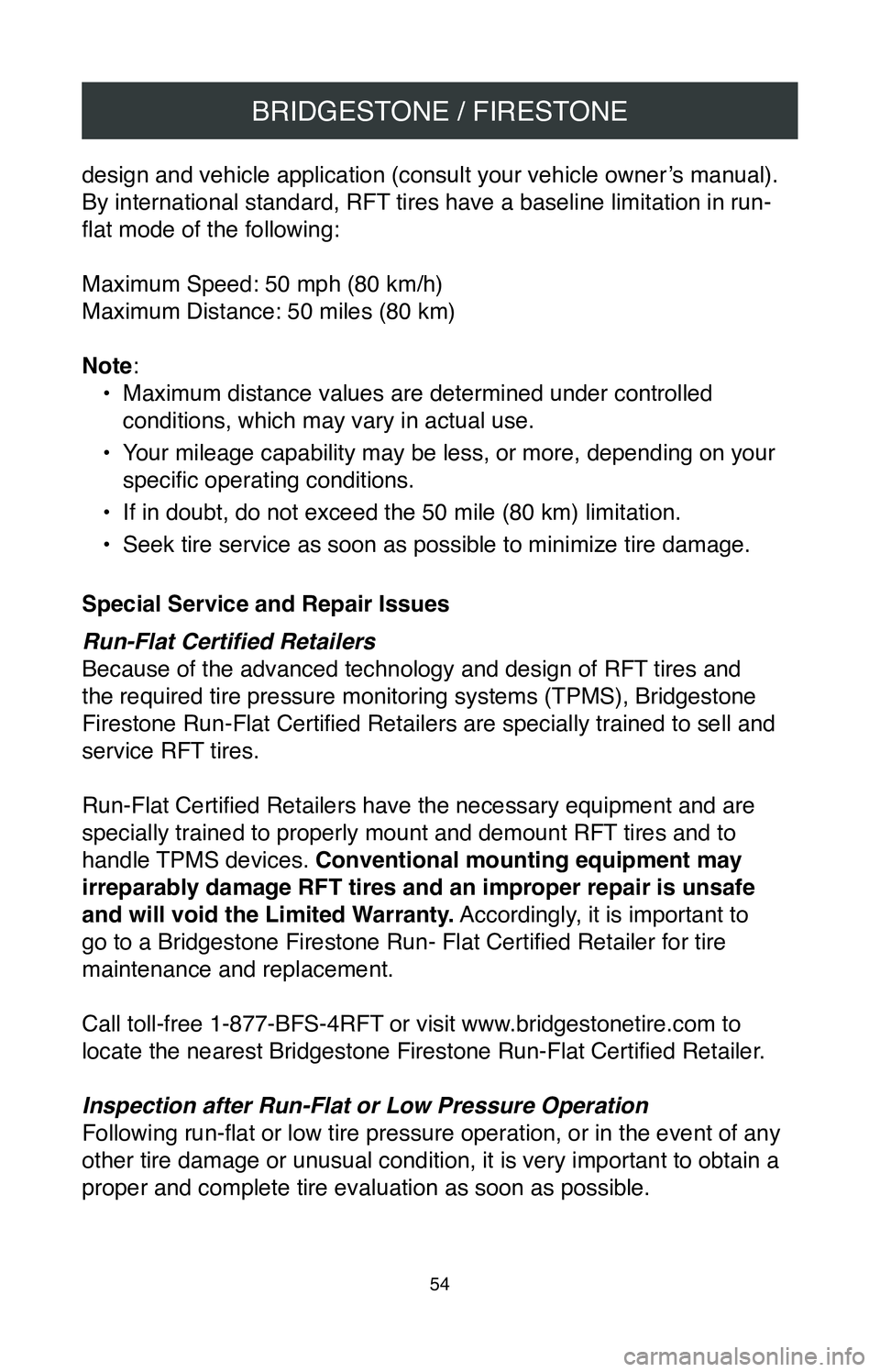
BRIDGESTONE / FIRESTONE
54
design and vehicle application (consult your vehicle owner’s manual).
By international standard, RFT tires have a baseline limitation in run-
flat mode of the following:
Maximum Speed: 50 mph (80 km/h)
Maximum Distance: 50 miles (80 km)
Note:•
Maximum distance values are determined under controlled
conditions, which may vary in actual use.
•
Your mileage capability may be less, or more, depending on your
specific operating conditions.
•
If in doubt, do not exceed the 50 mile (80 km) limitation.
•
Seek tire service as soon as possible to minimize tire damage.
Special Service and Repair Issues
Run-Flat Certified Retailers
Because of the advanced technology and design of RFT tires and
the required tire pressure monitoring systems (TPMS), Bridgestone
Firestone Run-Flat Certified Retailers are specially trained to sell and
service RFT tires.
Run-Flat Certified Retailers have the necessary equipment and are
specially trained to properly mount and demount RFT tires and to
handle TPMS devices. Conventional mounting equipment may
irreparably damage RFT tires and an improper repair is unsafe
and will void the Limited Warranty. Accordingly, it is important to
go to a Bridgestone Firestone Run- Flat Certified Retailer for tire
maintenance and replacement.
Call toll-free 1-877-BFS-4RFT or visit www.bridgestonetire.com to
locate the nearest Bridgestone Firestone Run-Flat Certified Retailer .
Inspection after Run-Flat or Low Pressure Operation
Following run-flat or low tire pressure operation, or in the event of any
other tire damage or unusual condition, it is very important to obtain a\
proper and complete tire evaluation as soon as possible.
Page 57 of 260
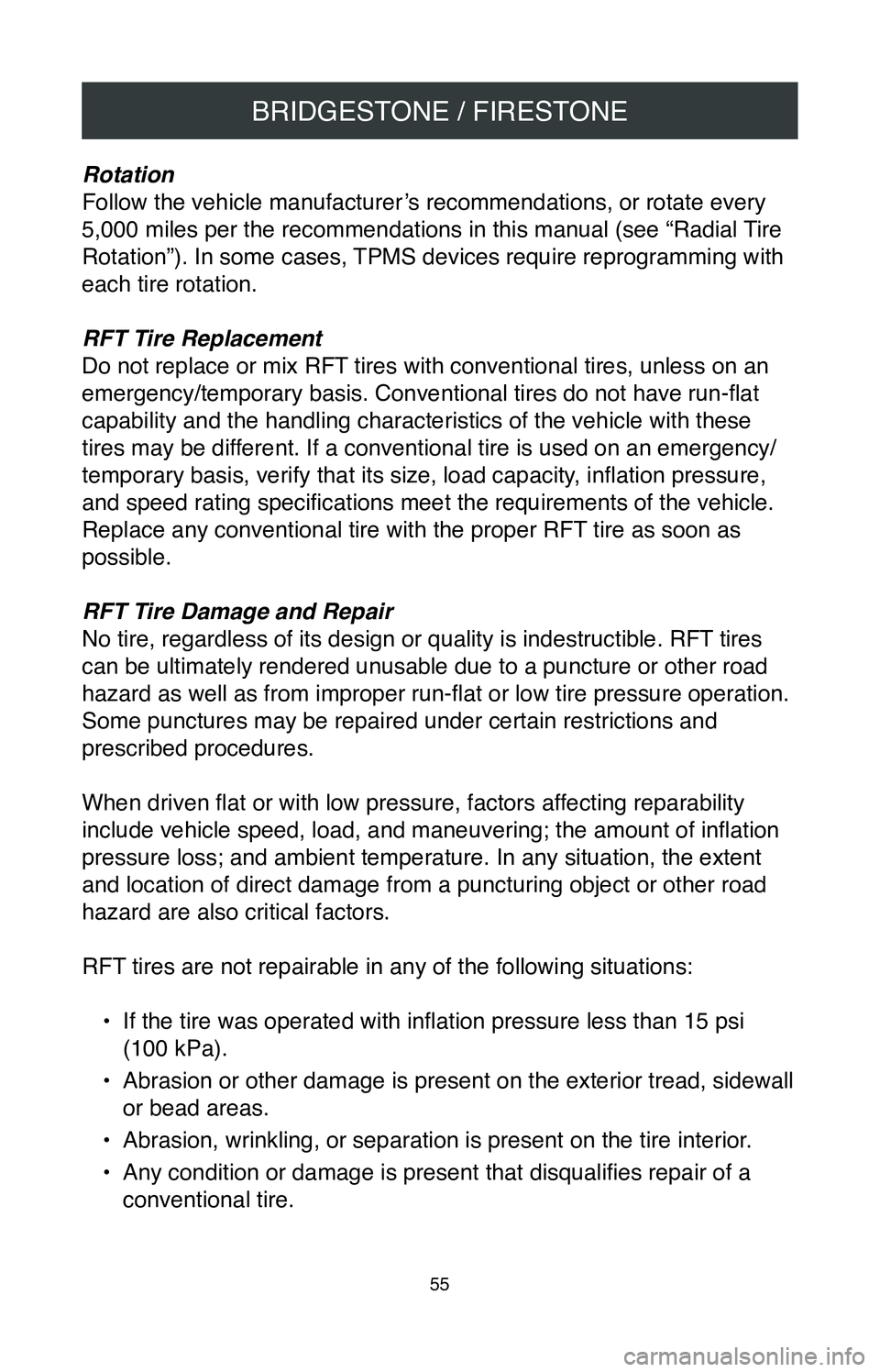
BRIDGESTONE / FIRESTONE
55
Rotation
Follow the vehicle manufacturer’s recommendations, or rotate every
5,000 miles per the recommendations in this manual (see “Radial Tire
Rotation”). In some cases, TPMS devices require reprogramming with
each tire rotation.
RFT Tire Replacement
Do not replace or mix RFT tires with conventional tires, unless on an
emergency/temporary basis. Conventional tires do not have run-flat
capability and the handling characteristics of the vehicle with these
tires may be different. If a conventional tire is used on an emergency/
temporary basis, verify that its size, load capacity, inflation pressure,
and speed rating specifications meet the requirements of the vehicle.
Replace any conventional tire with the proper RFT tire as soon as
possible.
RFT Tire Damage and Repair
No tire, regardless of its design or quality is indestructible. RFT tires
can be ultimately rendered unusable due to a puncture or other road
hazard as well as from improper run-flat or low tire pressure operation.
Some punctures may be repaired under certain restrictions and
prescribed procedures.
When driven flat or with low pressure, factors affecting reparability
include vehicle speed, load, and maneuvering; the amount of inflation
pressure loss; and ambient temperature. In any situation, the extent
and location of direct damage from a puncturing object or other road
hazard are also critical factors.
RFT tires are not repairable in any of the following situations:
•
If the tire was operated with inflation pressure less than 15 psi
(100 kPa).
•
Abrasion or other damage is present on the exterior tread, sidewall
or bead areas.
•
Abrasion, wrinkling, or separation is present on the tire interior.
•
Any condition or damage is present that disqualifies repair of a
conventional tire.
Page 58 of 260

BRIDGESTONE / FIRESTONE
56
Run-Flat Certified Retailers will fully inspect your tire, inside and out,
to determine if the tire can be repaired. Tire damage is not always
visible from the outside and the tire must be removed from the wheel
for a complete inspection. For more information, see the section “Tire
Repairs” in this manual.
Note: Some vehicle manufacturers do not recommend using repaired
tires. Consult your vehicle owner’s manual or contact the vehicle
manufacturer before operating a repaired tire on your vehicle.
Reference Information
Tire Sidewall Labeling
A lot can be learned by reading the tire’s sidewall. The following figures
show typical information on the sidewall of passenger (Figure 3) and
light truck tires (Figure 4):
Figure 3: Typical
Passenger Tire Markings
Figure 4: Typical Light
Truck Tire Markings
Page 62 of 260
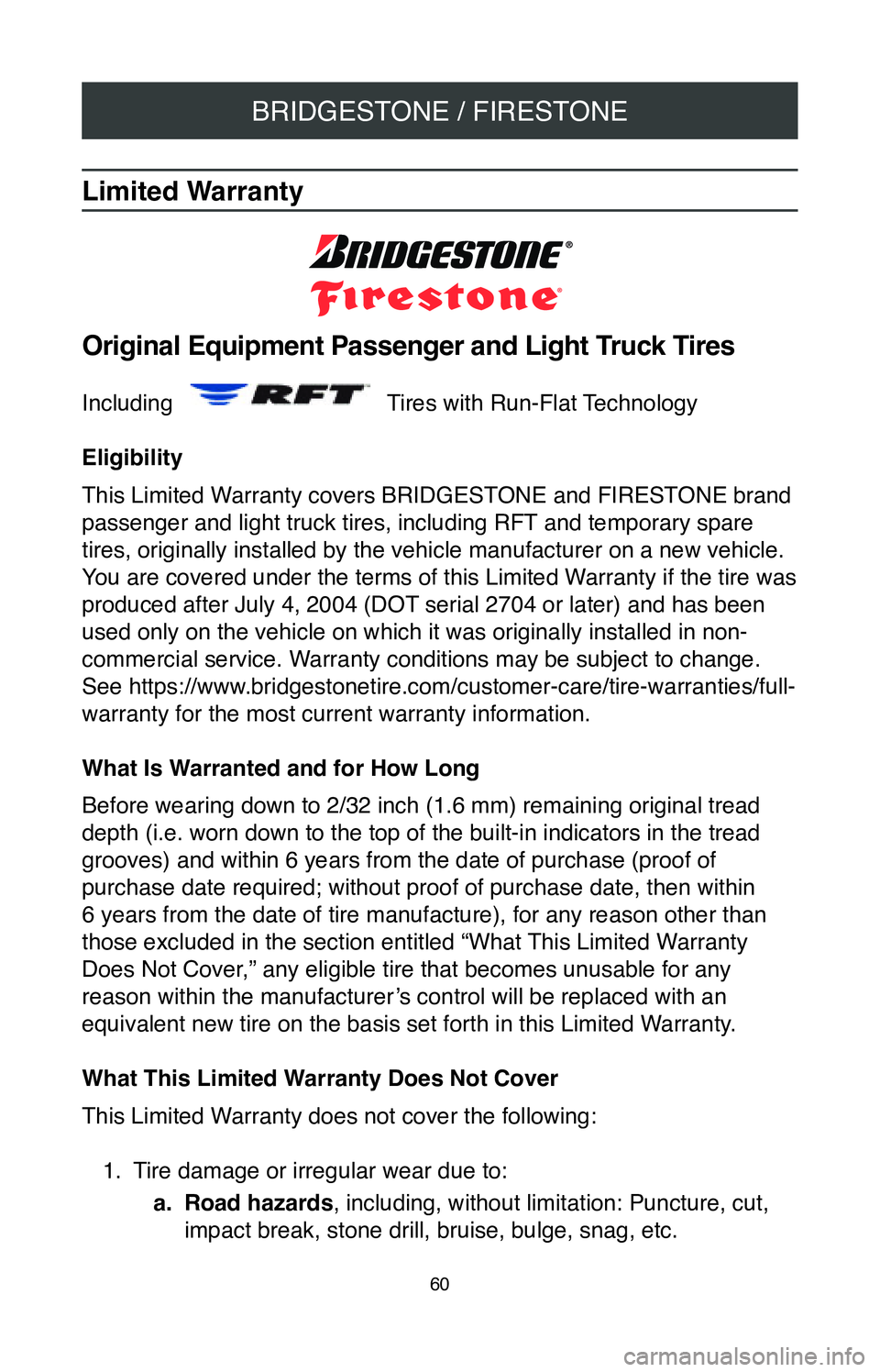
BRIDGESTONE / FIRESTONE
60
Limited Warranty
Original Equipment Passenger and Light Truck Tires
Including Tires with Run-Flat Technology
Eligibility
This Limited Warranty covers BRIDGESTONE and FIRESTONE brand
passenger and light truck tires, including RFT and temporary spare
tires, originally installed by the vehicle manufacturer on a new vehicle\
.
You are covered under the terms of this Limited Warranty if the tire was
produced after July 4, 2004 (DOT serial 2704 or later) and has been
used only on the vehicle on which it was originally installed in non-
commercial service. Warranty conditions may be subject to change.
See https://www.bridgestonetire.com/customer-care/tire-warranties/full-
warranty for the most current warranty information.
What Is Warranted and for How Long
Before wearing down to 2/32 inch (1.6 mm) remaining original tread
depth (i.e. worn down to the top of the built-in indicators in the tread
grooves) and within 6 years from the date of purchase (proof of
purchase date required; without proof of purchase date, then within
6 years from the date of tire manufacture), for any reason other than
those excluded in the section entitled “What This Limited Warranty
Does Not Cover,” any eligible tire that becomes unusable for any
reason within the manufacturer’s control will be replaced with an
equivalent new tire on the basis set forth in this Limited Warranty.
What This Limited Warranty Does Not Cover
This Limited Warranty does not cover the following: 1.
Tire damage or irregular wear due to:a.
Road hazards, including, without limitation: Puncture, cut,
impact break, stone drill, bruise, bulge, snag, etc.
Page 63 of 260

BRIDGESTONE / FIRESTONE
61
b. Improper use or operation, including, without limitation:
Improper inflation pressure, overloading, tire/wheel spinning,
use of an improper wheel, tire chain damage, misuse,
misapplication, negligence, tire alteration, or for racing or
competition purposes.
c.
Insufficient or improper maintenance , including, without
limitation: Failure to rotate tires as recommended in this
manual, wheel misalignment, worn suspension components,
improper tire mounting or demounting, tire/wheel assembly
imbalance, or other vehicle conditions, defects, or
characteristics.
d.
Contamination or degradation by petroleum products or
other chemicals, fire or other externally generated heat,
or water or other material trapped inside the tire during
mounting or inflation.
e.
Improper repair. Improper repair voids this Limited
Warranty.
f.
For RFT tires only, improper run-flat or low tire pressure
operation, including, without limitation: Exceeding speed,
distance, or other run-flat/low-pressure operation limitations.
2.
Rapid tread wear or wear-out. Original equipment tires have no
mileage warranty.
3.
Weather/ozone cracking after 4 years from date of tire
manufacture.
4.
Ride disturbance or vibration after 1/32 inch (0.8mm) of tread
wear use.
5.
Tires with sealant, balance, or other filler material that was not
originally applied or inserted by the tire manufacturer.
6.
Tires used in commercial service.
7.
Tires purchased and normally used outside the United States
and Canada.
8.
The cost of applicable federal, state, and local taxes.
9.
Failure to follow any of the safety and maintenance
recommendations or warnings contained in this manual.
This Limited Warranty is in addition to and/or may be limited by any
other applicable written warranty you may have received concerning
special tires or situations.
Page 72 of 260
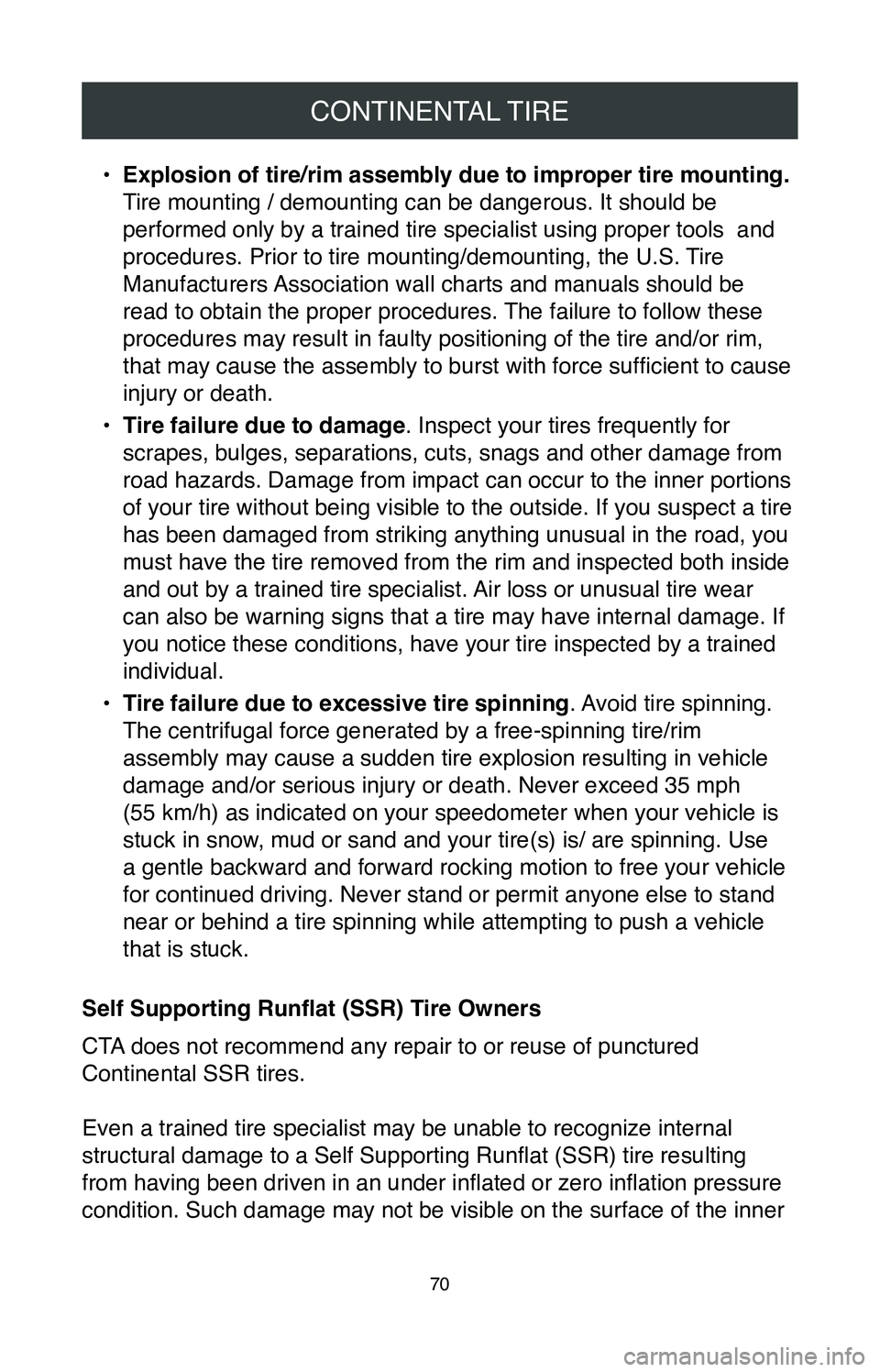
CONTINENTAL TIRE
70
• Explosion of tire/rim assembly due to improper tire mounting.
Tire mounting / demounting can be dangerous. It should be
performed only by a trained tire specialist using proper tools and
procedures. Prior to tire mounting/demounting, the U.S. Tire
Manufacturers Association wall charts and manuals should be
read to obtain the proper procedures. The failure to follow these
procedures may result in faulty positioning of the tire and/or rim,
that may cause the assembly to burst with force sufficient to cause
injury or death.
•
Tire failure due to damage. Inspect your tires frequently for
scrapes, bulges, separations, cuts, snags and other damage from
road hazards. Damage from impact can occur to the inner portions
of your tire without being visible to the outside. If you suspect a tire\
has been damaged from striking anything unusual in the road, you
must have the tire removed from the rim and inspected both inside
and out by a trained tire specialist. Air loss or unusual tire wear
can also be warning signs that a tire may have internal damage. If
you notice these conditions, have your tire inspected by a trained
individual.
•
Tire failure due to excessive tire spinning . Avoid tire spinning.
The centrifugal force generated by a free-spinning tire/rim
assembly may cause a sudden tire explosion resulting in vehicle
damage and/or serious injury or death. Never exceed 35 mph
(55 km/h) as indicated on your speedometer when your vehicle is
stuck in snow, mud or sand and your tire(s) is/ are spinning. Use
a gentle backward and forward rocking motion to free your vehicle
for continued driving. Never stand or permit anyone else to stand
near or behind a tire spinning while attempting to push a vehicle
that is stuck.
Self Supporting Runflat (SSR) Tire Owners
CTA does not recommend any repair to or reuse of punctured
Continental SSR tires.
Even a trained tire specialist may be unable to recognize internal
structural damage to a Self Supporting Runflat (SSR) tire resulting
from having been driven in an under inflated or zero inflation pressure
condition. Such damage may not be visible on the surface of the inner
Page 83 of 260
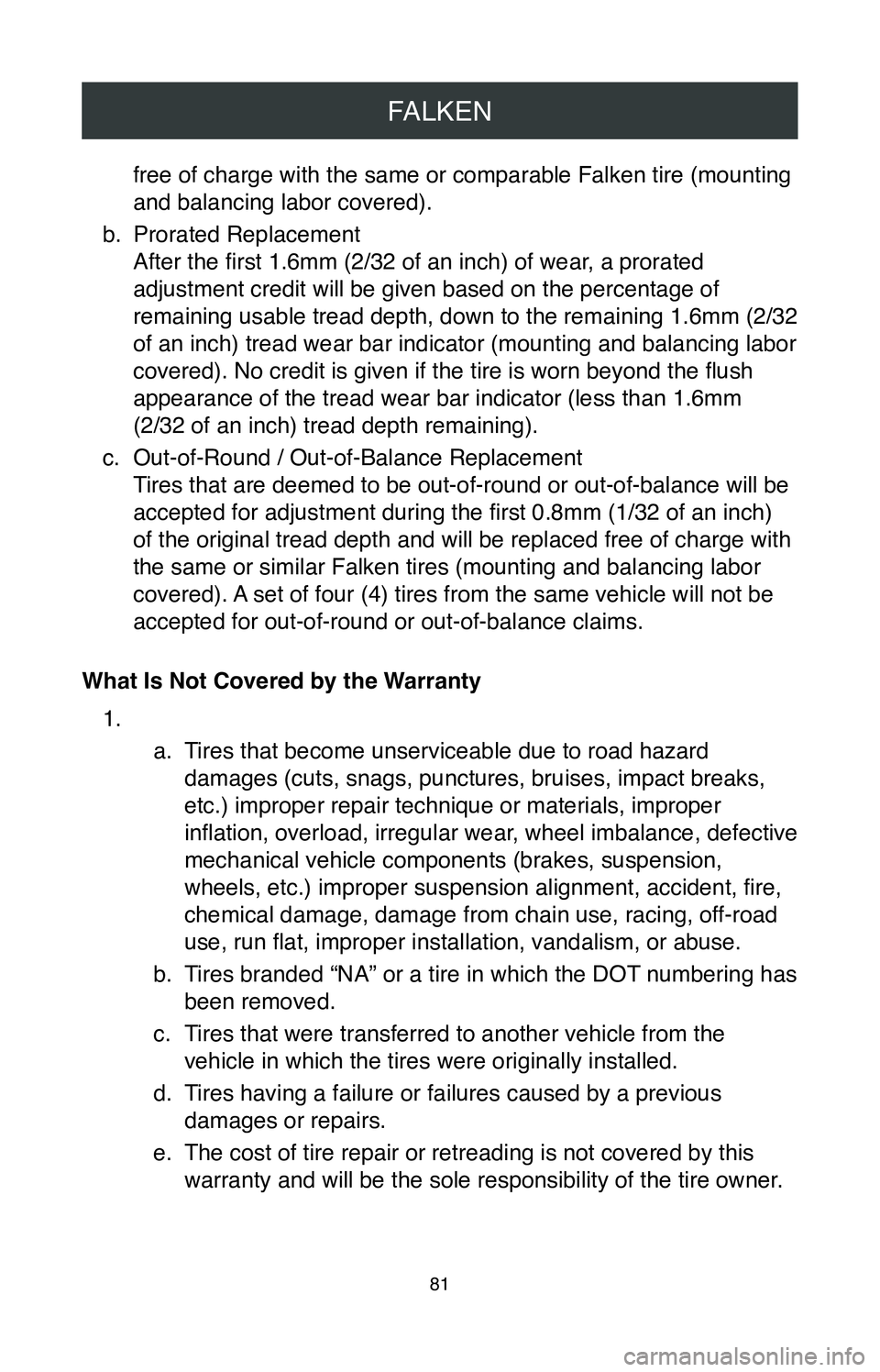
FALKEN
81
free of charge with the same or comparable Falken tire (mounting
and balancing labor covered).
b.
Prorated Replacement
After the first 1.6mm (2/32 of an inch) of wear, a prorated
adjustment credit will be given based on the percentage of
remaining usable tread depth, down to the remaining 1.6mm (2/32
of an inch) tread wear bar indicator (mounting and balancing labor
covered). No credit is given if the tire is worn beyond the flush
appearance of the tread wear bar indicator (less than 1.6mm
(2/32 of an inch) tread depth remaining).
c.
Out-of-Round / Out-of-Balance Replacement
Tires that are deemed to be out-of-round or out-of-balance will be
accepted for adjustment during the first 0.8mm (1/32 of an inch)
of the original tread depth and will be replaced free of charge with
the same or similar Falken tires (mounting and balancing labor
covered). A set of four (4) tires from the same vehicle will not be
accepted for out-of-round or out-of-balance claims.
What Is Not Covered by the Warranty 1.
a. Tires that become unserviceable due to road hazard
damages (cuts, snags, punctures, bruises, impact breaks,
etc.) improper repair technique or materials, improper
inflation, overload, irregular wear, wheel imbalance, defective
mechanical vehicle components (brakes, suspension,
wheels, etc.) improper suspension alignment, accident, fire,
chemical damage, damage from chain use, racing, off-road
use, run flat, improper installation, vandalism, or abuse.
b.
Tires branded “NA” or a tire in which the DOT numbering has
been removed.
c.
Tires that were transferred to another vehicle from the
vehicle in which the tires were originally installed.
d.
Tires having a failure or failures caused by a previous
damages or repairs.
e.
The cost of tire repair or retreading is not covered by this
warranty and will be the sole responsibility of the tire owner.
Page 100 of 260
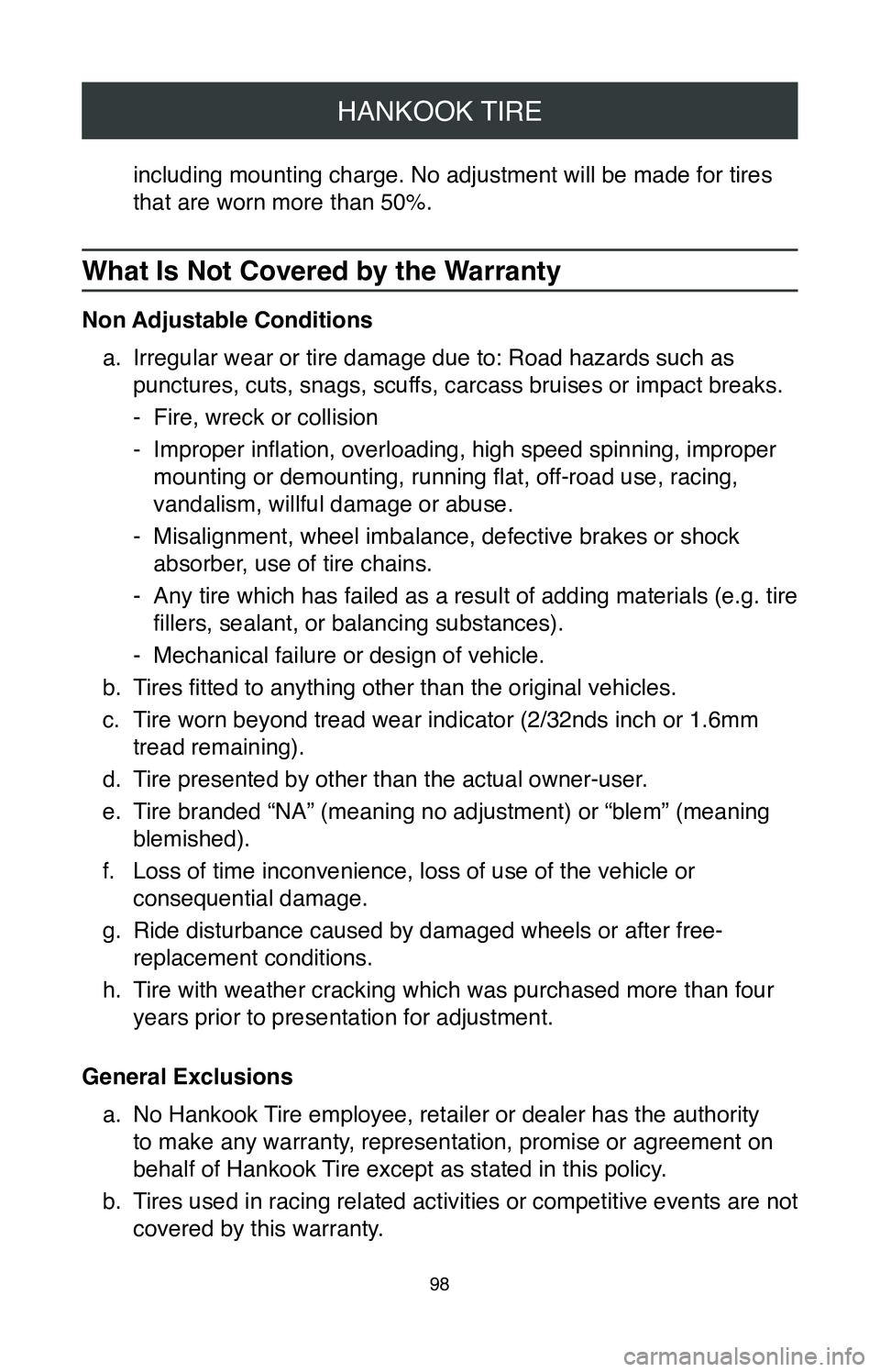
HANKOOK TIRE
98
including mounting charge. No adjustment will be made for tires
that are worn more than 50%.
What Is Not Covered by the Warranty
Non Adjustable Conditionsa.
Irregular wear or tire damage due to: Road hazards such as
punctures, cuts, snags, scuffs, carcass bruises or impact breaks.
-Fire, wreck or collision
- Improper inflation, overloading, high speed spinning, improper
mounting or demounting, running flat, off-road use, racing,
vandalism, willful damage or abuse.
-Misalignment, wheel imbalance, defective brakes or shock
absorber, use of tire chains.
- Any tire which has failed as a result of adding materials (e.g. tire
fillers, sealant, or balancing substances).
-Mechanical failure or design of vehicle.
b.
Tires fitted to anything other than the original vehicles.
c.
Tire worn beyond tread wear indicator (2/32nds inch or 1.6mm
tread remaining).
d.
Tire presented by other than the actual owner-user.
e.
Tire branded “NA” (meaning no adjustment) or “blem” (meaning
blemished).
f.
Loss of time inconvenience, loss of use of the vehicle or
consequential damage.
g.
Ride disturbance caused by damaged wheels or after free-
replacement conditions.
h.
Tire with weather cracking which was purchased more than four
years prior to presentation for adjustment.
General Exclusions a.
No Hankook Tire employee, retailer or dealer has the authority
to make any warranty, representation, promise or agreement on
behalf of Hankook Tire except as stated in this policy.
b.
Tires used in racing related activities or competitive events are not
covered by this warranty.
Page 103 of 260
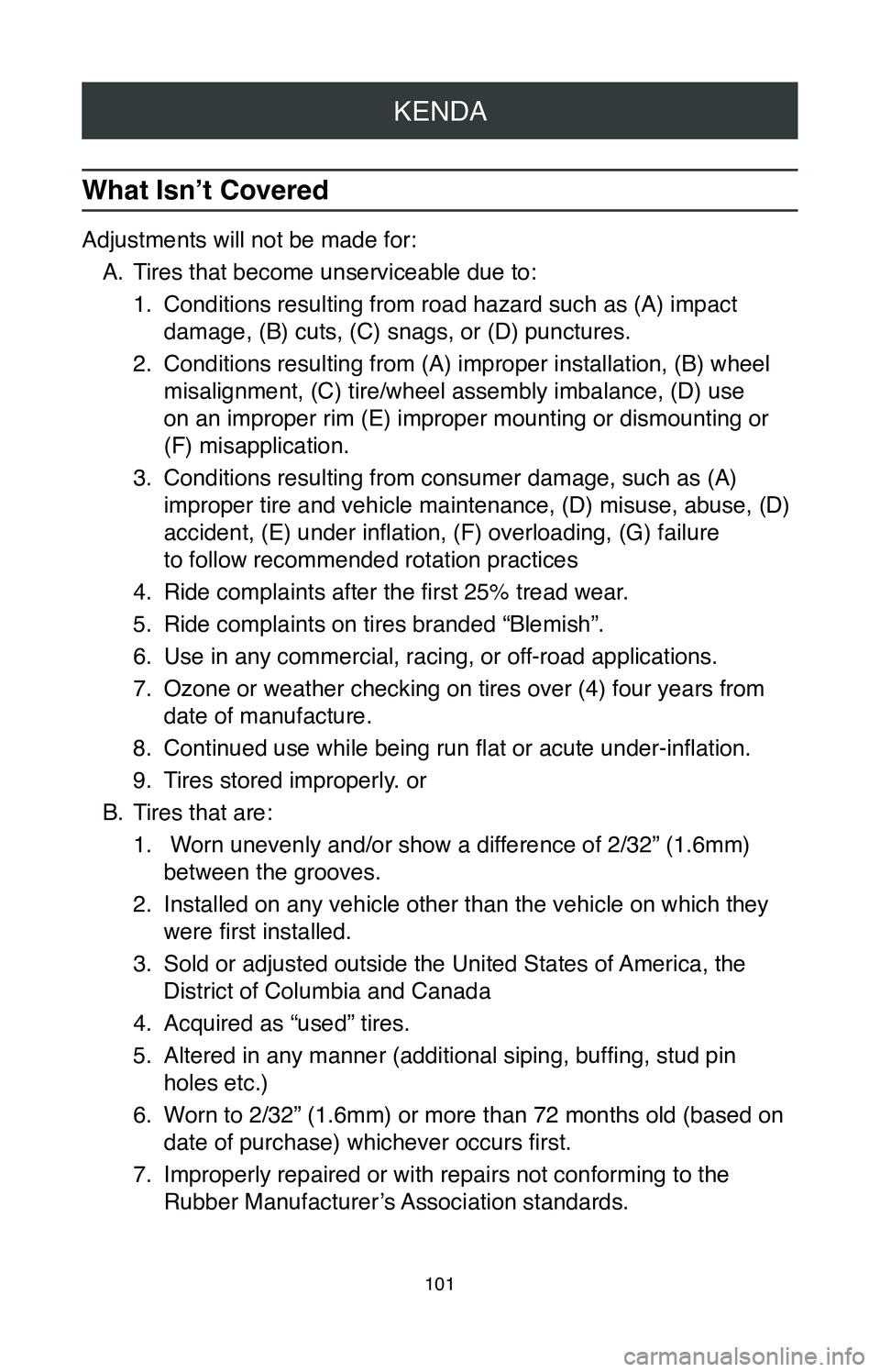
KENDA
101
What Isn’t Covered
Adjustments will not be made for:A.
Tires that become unserviceable due to:
1.
Conditions resulting from road hazard such as (A) impact
damage, (B) cuts, (C) snags, or (D) punctures.
2.
Conditions resulting from (A) improper installation, (B) wheel
misalignment, (C) tire/wheel assembly imbalance, (D) use
on an improper rim (E) improper mounting or dismounting or
(F) misapplication.
3.
Conditions resulting from consumer damage, such as (A)
improper tire and vehicle maintenance, (D) misuse, abuse, (D)
accident, (E) under inflation, (F) overloading, (G) failure
to follow recommended rotation practices
4.
Ride complaints after the first 25% tread wear.
5.
Ride complaints on tires branded “Blemish”.
6.
Use in any commercial, racing, or off-road applications.
7.
Ozone or weather checking on tires over (4) four years from
date of manufacture.
8.
Continued use while being run flat or acute under-inflation.
9.
Tires stored improperly. or
B.
Tires that are:
1.
Worn unevenly and/or show a difference of 2/32” (1.6mm)
between the grooves.
2.
Installed on any vehicle other than the vehicle on which they
were first installed.
3.
Sold or adjusted outside the United States of America, the
District of Columbia and Canada
4.
Acquired as “used” tires.
5.
Altered in any manner (additional siping, buffing, stud pin
holes etc.)
6.
Worn to 2/32” (1.6mm) or more than 72 months old (based on
date of purchase) whichever occurs first.
7.
Improperly repaired or with repairs not conforming to the
Rubber Manufacturer’s Association standards.